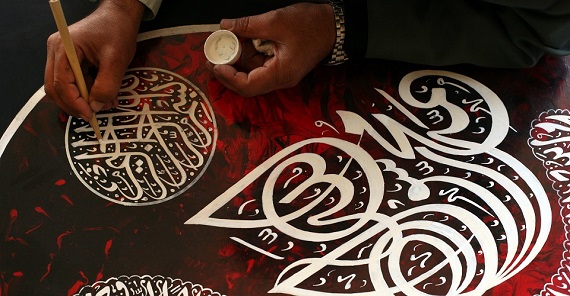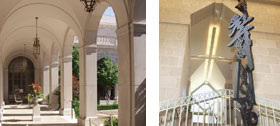
Afghan Creativity, Resilience and Hope Are Highlighted in Dynamic Exhibition
“Turquoise Mountain: Artists Transforming Afghanistan” To Open March 5
Braden Bradley (212) 847-9890; braden.bradley@gsmltd.net
December 17, 2015
“Turquoise Mountain: Artists Transforming Afghanistan” will convert the Smithsonian’s International Gallery into a space that evokes the vibrant marketplace of Old Kabul with artisans demonstrating their skills in jewelry making, woodworking, calligraphy, ceramics, carpet weaving and other crafts.
“This exhibition highlights the vitality of these new Afghan artisans and demonstrates the power of art and culture to tell the story of artistic creativity, resilience and hope,” said Julian Raby, The Dame Jillian Sackler Director of the Arthur M. Sackler Gallery and Freer Gallery of Art. “This is a powerful moment meant to transcend the headlines of war and conflict.”
The exhibition, presented by the Smithsonian’s Freer Gallery of Art and Arthur M. Sackler Gallery from March 5, 2016, through Oct. 29, 2017, invites visitors to experience the rebirth of Afghanistan’s cultural legacy after decades of conflict and neglect.
Turquoise Mountain is a British charity based in Afghanistan that works with Afghan artisans and architects to revive the country’s cultural heritage and revitalize Murad Khani, Kabul’s historic Old City where artisans live and work. Established in 2006, Turquoise Mountain was founded at the request of HRH Prince Charles, the Prince of Wales.
The immersive exhibition will include:
- Eighteen visiting Afghan artisans, many of whom are teachers and young entrepreneurs, who will share their experiences and demonstrate their skills
- A caravanserai, a courtyard that served as a gathering and resting place for Silk Road travelers, recreated with more than three tons of hand-carved Himalayan cedar and that includes two 30-foot colonnaded arches and artisan stalls, embellished with colorful toshaks, Afghan cushions, where visitors may sit and take in the dynamic exhibition
- Immersive video and large-scale photographs
- An interactive touchscreen map of Afghanistan that allows visitors to explore the history of the region and explore its artistic traditions
- A social-media wall with current visitor feedback and changing content
Afghanistan is located at the heart of ancient Silk Road trade routes, and for more than 3,500 years it blended traditions from India, Persia and Central Asia into a distinct artistic culture. Decades of civil unrest that began in the 1970s nearly destroyed this vital heritage. Artisans were often forced to leave their country or give up their craft. The Old City of Kabul—Murad Khani, the once bustling center of craft and commerce in Afghanistan’s largest metropolis—fell into ruin.
Turquoise Mountain, named for a lost 12th-century city in Afghanistan, was founded at the request of HRH Prince Charles and Mohammed Karzai, the then-president of Afghanistan. The charity is reviving the nation’s proud cultural legacy by transforming Murad Khani from slum conditions into a vibrant cultural and economic hub.
“Since we started about 10 years ago, Turquoise Mountain and the artisans of Kabul have been, I hope, a very tangible and visible symbol of cooperation between the community of Murad Khani, the government of Afghanistan and the international community,” said Shoshana Stewart, CEO of the Turquoise Mountain. “Now, we can bring their story to the American public.”
“Turquoise Mountain: Artists Transforming Afghanistan” is organized by the Arthur M. Sackler Gallery and Turquoise Mountain.
This exhibition is made possible by the support the American people have given to Turquoise Mountain through the United States Agency for International Development (USAID). Since 2008, USAID support has provided education and training to Turquoise Mountain increasing economic opportunities and incomes for artists and participants. Exhibition contents are the responsibility of Turquoise Mountain and the Smithsonian Institution and do not necessarily reflect the views of USAID or the U.S. Government.
Public Programs and Festivals
Throughout the spring and summer of 2016, visiting Afghan artisans will demonstrate wood carving, jewelry making, calligraphy and ceramics; participate in panels on the global craft movement; and lead family art-making workshops. They will also engage with local artisans and Washington, D.C.’s large Afghan American community. All are among the finest practitioners of their craft working today, and for many, this is their first trip to the U.S.
On March 5, the Freer and Sackler galleries’ largest annual festival, “Nowruz: A Persian New Year,” will mark the exhibition’s opening with a daylong family celebration of food, music, storytelling and crafts. Nowruz marks the New Year for many countries in the Near East and Central Asia, including Afghanistan.
About the Freer and Sackler Galleries
The Smithsonian’s Freer Gallery of Art and the adjacent Arthur M. Sackler Gallery, located on the National Mall in Washington, D.C., together comprise the nation’s museum of Asian art. It contains one of the most important collections of Asian art in the world, featuring more than 40,000 objects ranging in time from the Neolithic to the present day, with especially fine groupings of Islamic art, Chinese jades, bronzes and paintings and the art of the ancient Near East. The galleries also contain important masterworks from Japan, ancient Egypt, South and Southeast Asia and Korea, as well as the Freer’s noted collection of works by American artist James McNeill Whistler. The Freer, which will be closed during the exhibition, is scheduled to reopen in spring 2017 with modernized technology and infrastructure, refreshed gallery spaces and an enhanced Eugene and Agnes E. Meyer Auditorium.
About Turquoise Mountain
Founded in 2006 at the request of the Prince of Wales and the then-president of Afghanistan HE Hamid Karzai by Rory Stewart OBE (author of The Places in Between), Turquoise Mountain has trained hundreds of artisans in traditional arts, rebuilt 112 historic buildings in the Murad Khani district of the historic Old City of Kabul, set up a local primary school and family health clinic serving more than 20,000 patients per year, organized major international exhibitions from the Venice Biennale to the Museum of Islamic Art in Doha and established partnerships with prestigious international retailers from Bloomingdales and Kate Spade in New York, to Pippa Small and Monsoon-Accessorize in London.
###

Contact us
pressasia@si.eduTel: 202.633.0271
Fax: 202.633.0046
Office of Marketing and Communications
Freer Gallery of Art and Arthur M. Sackler Gallery
PO Box 37012, MRC 707
Washington, DC 20013-7012